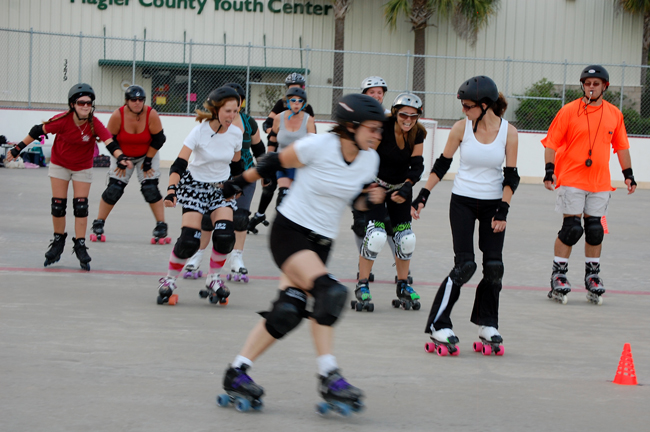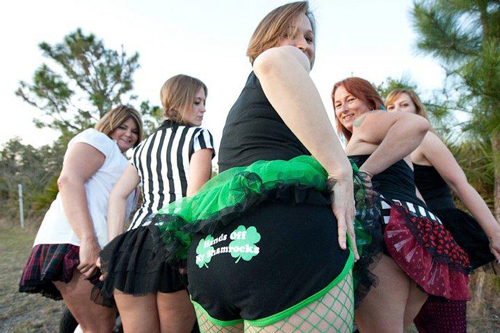
To the uninitiated eye, and especially to the sexist eye, it can be violently raw, sexual, seemingly exploitative and unbound by ordinary rules of gamesmanship. Yet roller derby in its present form–dominated as it is by amateur women who formed their own grass-root leagues and nurtured them to prominence and popularity between bouts of mothering, suburban responsibilities and professional lives–is more disciplined and controlled, and empoweringly feminist, than you know. The violence is there. So is the sexuality. But either are expressed entirely on the women’s terms, on their turf, and more than anything, at their pleasure.
“Because I’m a pre-school teacher,” says Kathleen Frassrand, best and only known as Kit Kat Krusher in the rink, “I have to be all sweetness and light during the day, and lovey, and you know, helpin’ my kids and I’m there. I get on the roller derby track, and that’s where I get out all my aggression, that’s where I get out any kinda nastiness I want to. I can look at my roller derby girls and I can call them every name in the book. And they know it’s just fun.”
Click On:
- The Palm Coast Derby Beaches (Formerly Derby Dolls) Web Site
- USA Roller Sports’ Derby Page
- Drew’s Whip It
This isn’t happening at Madison Square Garden or in a Drew Barrymore fantasy. It’s happening every Monday and Friday evening from 5:15 to 6:45 in the unforgiving concrete hockey rink of the Youth Services building on the campus of Flagler Palm Coast High School. Kit Kat Krusher is one of the Palm Coast Derby Beaches, the creation of Amanda Grablin, a.k.a. Malicious Man D, a Colorado transplant who had her first roller derby experience in Denver not long ago, for just two months. She got pregnant, moved, gave birth (not necessarily in that order), and in February Grablin decided to mount up a team in Palm Coast on a wing and a web chat: she posted an invitation on Flaglerchat and on Craigslist, exchanged a few emails, and drew six people, five of whom– “The Originals” — are still with her. Many more joined subsequently, hardly any of whom had ever roller derbied. The team, now 20-strong, has been adding at least one new girl at every practice. And no, they never refer to each other as women. They’re girls.
Malicious Man D Mans Up[media id=20 width=250 height=100]
Grablin is shooting for the team to have its own “bout,” as roller derby competitions are called, in November, either in Bunnell or in Ormond Beach. Meanwhile, it’s about battling a few false perceptions and, more than anything, hitting the rink and enjoying the hell out of it.
“As soon as you hear roller derby you think of burly girls with tattoos all the way up their arms,” Grablin/Malicious says. “But really, it’s a bunch of girls that just want to get together, have fun, get away from the real world for a little while, take out some aggressions on other girls that want to take their aggressions out. It’s just about having fun. When you put your helmet on, you’re a different person. And then when you take your helmet off, you take your skates off, you’re back to mama, you’re back to nurse, whatever, we have teachers, we have everybody here. You wouldn’t know, seeing us out in public, that we’re a derby girl. You wouldn’t know that until you came out here and met us personally.”
The team originally named itself the Palm Coast Derby Dolls, but the name is already taken, and derby leagues are ferociously proprietary about their trademarks down to the names of competitors: every single one of them must be unique. Those obligatory rink names are the girls’ identity. And so you have Malicious Man D, Gypsea Thunder, Empress Pain, Melly Hatchet, SpiKeY B REF, T.J., DlizSHIZ, Kim-A-Kazi, and of course Kit Kat Krusher, whose jersey number is 68+1. “You know,” she says, “roller derby is all about tiny skirts and fishnet stockings and you know, you’ll see the number sixty-nine everywhere in derby, everywhere, which is why I’m 68 plus one, because I’m just this side of naughty. I’m not really naughty. I’m mostly good.”
Gypsea Thunder’s Tale[media id=21 width=250 height=100]
Age doesn’t figure much in the players’ minds. Sandy Shay (Gypsea Thunder), one of two team captains, is 38. The oldest player is 39. The youngest is 21. The cut-off age is 18. Attention shuffleboard obsessives: There is no cut-off age at the higher end. Joining isn’t cheap, though it’s less than the average cable bill: the $30 a month covers annual dues for the team’s membership in USA Roller Sports, the governing body for competitive roller sports in the United States, team shirts, set-up costs, the team’s administrative costs (it’s a limited liability company registered in Florida), and will eventually cover the cost of competing in proper venues out of town, since Palm Coast’s rink at the high school wouldn’t accommodate either competition or spectators, and the city’s event fee is steeper than elsewhere.
The game isn’t difficult to get a handle on, either as a player or a spectator, though it may be more difficult to master its subtleties. It’s been around longer than most people assume, too. The game’s popularity grew with its visibility in the 1970s. But its American invention dates back to the 1930s.

The brief article described what has changed little since then: skaters use ordinary rollers on a banked, oval track. Two teams simultaneously play offense and defense against each other in four 15-minute periods. To score, a skater, called a jammer (not in the Times article, that term), “must lap the track against the opposing team within a two-minute period. The defense of the opposition may take any form except pushing with the hands. A body check is one of the favorite forms of defense.”
Kit Kat Krusher Uncensored[media id=19 width=250 height=100]
There’s violence. Take-downs. Rink rash, as players call it. But there’s also plenty of skill in learning how to fall, knee-slides, double-knee slides, supermans and all sorts of other means of building “muscle memory” that preempts bad falls. The game has turned more gentle than its anarchic version in the 1970s, when it was, not coincidentally, more populated by men. “Nowadays,” Kit Kat Krusher says, “it’s not nearly as violent as it used to be. We have a lot more rules about what you can and cannot do. I can tell you unequivocally, it is not scripted. Every time I get hit and I bounce off concrete, I can tell you, it’s not scripted. We end up with rink rash. You know my big joke now is, now that I’m in roller derby I have to find a guy who likes bruisies and blisters. I have to find a guy who thinks that’s sexy, because I’m not giving up roller derby. I love it. I absolutely love it.”
![]()
The Palm Coast Derby Beaches practice every Monday and Friday from 5:15 to 6:45 p.m. at the Youth Center’s hockey rink on the Flagler Palm Coast High School campus. Additional members (women only) are welcome at all skill levels, but team founders warn: you must be able to take a hit without crying, be willing to learn and take corrective criticism, and provide your own skates and protective gear in addition to the $30 monthly fee. The league is also looking for volunteers, men and women. For more information, contact the league at [email protected].






























mandy says
Love, love, love it!
Jim Guines says
What a great story about a little known movement in the community that will inform a lot of potential interest. I grew up on roller derby, not playing it, but watching it live as well as on t.v. I hope theyt have some room at the site for spectators because I plan to go and watch the practice!!!
Malicious Man D says
Everyone is welcome to come and watch. We scrimmage the last 30 minutes of every practice so if you want to see action, this is when you should come!